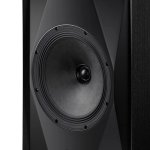It is on previous page, post #15. I just added one extra capacitor 100 nF across the last pair of drivers.
I found this old thread while playing with the idea of short curved arrays. I just put together a quick and dirty simulation of 8 element 3FE22 array (only with 0 and 45 deg measurements) in VituixCAD. Do these results make any sense? First is a flat baffle without the circuit, second is the flat baffle with the circuit and the third one is curved baffle with 1 m radius and the circuit.
This is good stuff.
Notice that the vertical beamwidth broadens in the second simulation. The beam basically goes from being about 18" tall to 2-3X as tall.
Though a lot of people love the sound of CBTs, some do not. I notice in the 2nd sim that the high frequencies are not as loud.
It's hard to tell at first; it looks like the BASS gets louder. But that's not it; the treble is getting QUIETER it's just that the scale of the graph shifts from the 1st to 2nd sims.
Perhaps some people prefer the sound of plain ol' straight arrays (with no delay) because the curvature of a curved line (whether curved physically OR electronically) will spread the highs out wider, and since the same amount of energy is now radiated into a wider angle, it's spread out. IE, it's quieter ON AXIS at high frequency.
This is a problem for CBTs, as it's really hard to get ANY driver to play to 20khz, much less a 2.5" or 3.5" driver in an array. (A single 2.5" can do it with no problem.)
Shower thought: the ideal tweeter for a CBT would have a "natural" response that's rising, ideally A LOT.
I've mentioned this a hundred times, but based on conversations I've had with Andrew Jones, he opts for soft dome tweeters because they have a rising response at high frequency. This is because the 'tip' of the dome decouples at high frequency, which makes the tweeter behave as if it's MMS is less than it really is.
IE, when the dome decouples, only the edge of the dome attached to the surround is moving. The motor force doesn't change. Net effect is that response rises. Basic "F=MA"
The first attached pic shows one of Andrew's recent speakers
The second attached pic shows the LaVoce TN131. Note how the high frequency response rises.
The TN100 - which is 75% as wide as the TN131 - doesn't exhibit this behavior as much. My 'hunch' is that the SMALLER tweeter decouples LESS than the large tweeter. With a metal dome tweeter, this wouldn't happen, but a soft dome isn't remotely as rigid. It de-couples.
I've mentioned this a hundred times, but based on conversations I've had with Andrew Jones, he opts for soft dome tweeters because they have a rising response at high frequency. This is because the 'tip' of the dome decouples at high frequency, which makes the tweeter behave as if it's MMS is less than it really is.
IE, when the dome decouples, only the edge of the dome attached to the surround is moving. The motor force doesn't change. Net effect is that response rises. Basic "F=MA"
The first attached pic shows one of Andrew's recent speakers
The second attached pic shows the LaVoce TN131. Note how the high frequency response rises.
The TN100 - which is 75% as wide as the TN131 - doesn't exhibit this behavior as much. My 'hunch' is that the SMALLER tweeter decouples LESS than the large tweeter. With a metal dome tweeter, this wouldn't happen, but a soft dome isn't remotely as rigid. It de-couples.

